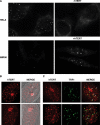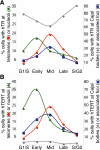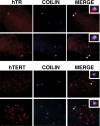Cell cycle-regulated trafficking of human telomerase to telomeres
- PMID: 16339074
- PMCID: PMC1356603
- DOI: 10.1091/mbc.e05-09-0903
Cell cycle-regulated trafficking of human telomerase to telomeres
Abstract
Telomerase synthesizes telomeres at the ends of human chromosomes during S phase. The results presented here suggest that telomerase activity may be regulated by intranuclear trafficking of the key components of the enzyme in human cells. We examined the subcellular localization of endogenous human telomerase RNA (hTR) and telomerase reverse transcriptase (hTERT) in HeLa cervical carcinoma cells. Throughout most of the cell cycle, we found that the two essential components of telomerase accumulate at intranuclear sites separate from telomeres. However, during S phase, both hTR and hTERT are specifically recruited to subsets of telomeres. The localization of telomerase to telomeres is dynamic, peaking at mid-S phase. We also found complex associations of both hTR and hTERT with nucleoli and Cajal bodies during S phase, implicating both structures in the biogenesis and trafficking of telomerase. Our results mark the first observation of human telomerase at telomeres and provide a mechanism for the cell cycle-dependent regulation of telomere synthesis in human cells.
Figures






References
Publication types
MeSH terms
Substances
Grants and funding
LinkOut - more resources
Full Text Sources
Other Literature Sources
Molecular Biology Databases

